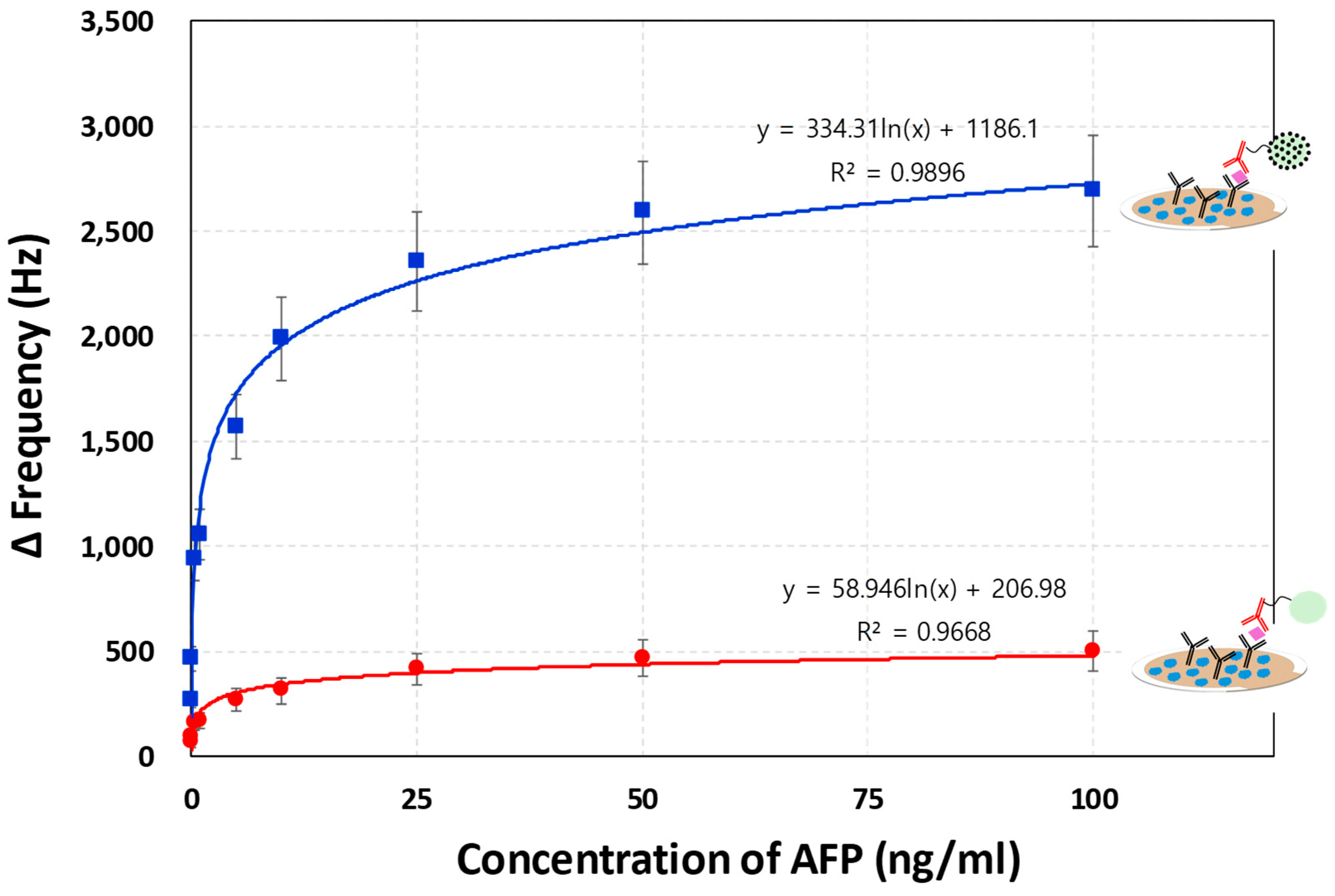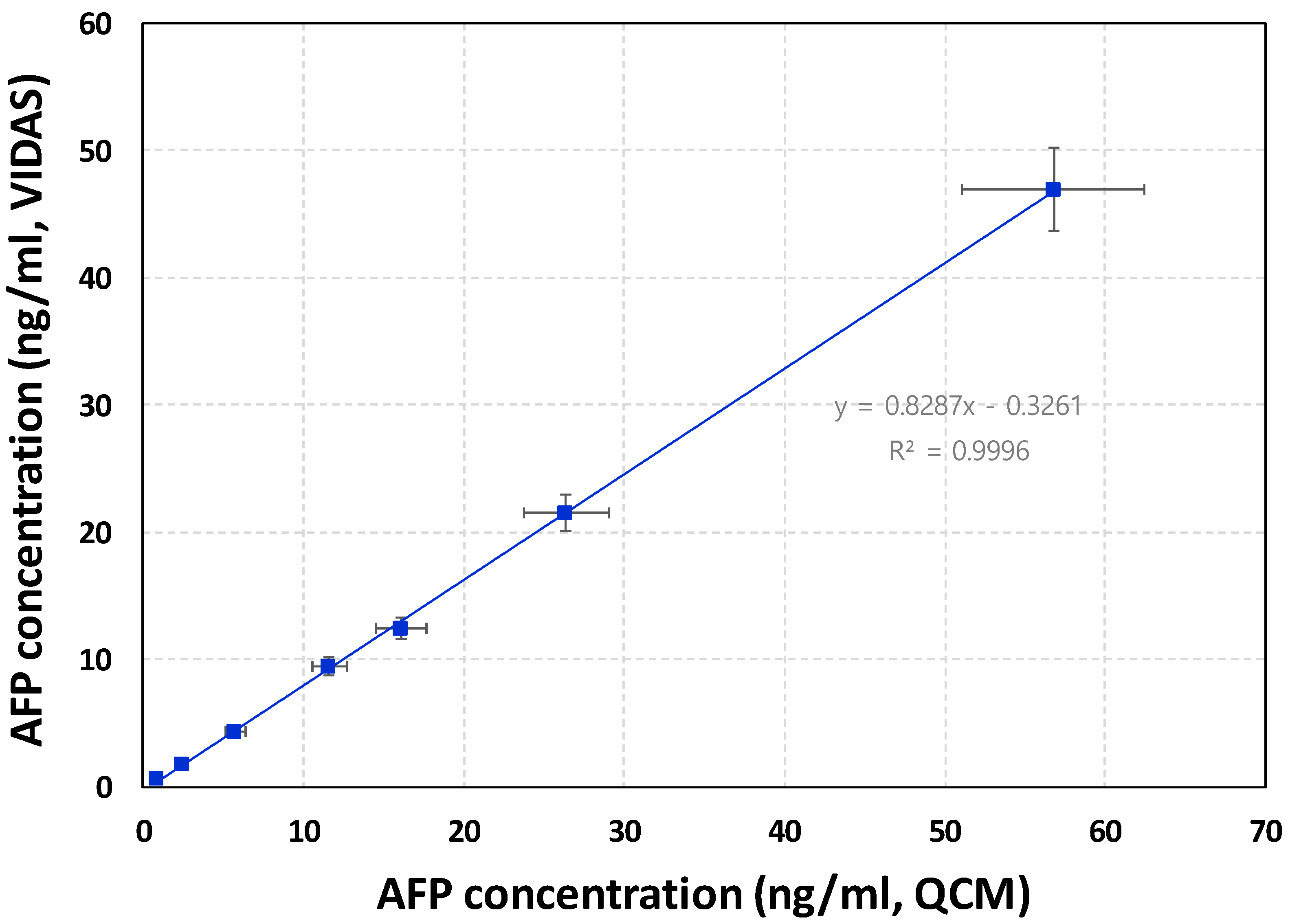Tungsten Oxide-Mediated Photocatalytic Silver Enhancement in a QCM Immunosensor for Alpha-Fetoprotein Detection
Abstract
1. Introduction
2. Materials and Methods
2.1. Reagent and Materials
2.2. Design and Configuration of the QCM Measurement System
2.3. X-Ray Diffraction (XRD) Analysis
2.4. Transmission Electron Microscopy (TEM) Characterization of WO3 and WO3/Ag Hybrid Nanostructures
2.5. UV–Vis Spectroscopic Analysis of Silver-Doped WO3 Nanostructures
2.6. Preparation of Antibody-Conjugated WO3 Nanoparticles for AFP Biosensing
2.7. WO3-Mediated Photocatalytic Silver Staining in Sandwich Immunoassay for AFP Detection
3. Results and Discussion
3.1. Strategies for Sensitive AFP Immunoassay: Detection and Signal Amplification Approaches
3.2. Signal Amplification Process: WO3-Based Photocatalytic Silver Staining
3.3. Real-Time QCM Sensor Response for AFP Detection
3.4. Improving AFP Detection Sensitivity Using WO3-Mediated Photocatalytic Silver Staining
3.5. Evaluation of QCM Sensor Performance Using Blind-Spiked AFP Samples
4. Conclusions
Supplementary Materials
Author Contributions
Funding
Institutional Review Board Statement
Informed Consent Statement
Data Availability Statement
Acknowledgments
Conflicts of Interest
References
- Passaro, A.; Bakir, M.A.; Hamilton, E.G.; Diehn, M.; Andre, F.; Roy-Chowdhuri, S.; Mountzios, G.; Wistuba, I.I.; Swanton, C.; Peters, S. Cancer biomarkers: Emerging trends and clinical implications for personalized treatment. Cell 2024, 187, 1617–1635. [Google Scholar] [CrossRef] [PubMed]
- Das, S.; Dey, M.K.; Devireddy, R.; Gartia, M.R. Biomarkers in cancer detection, diagnosis, and prognosis. Sensors 2023, 24, 37. [Google Scholar] [CrossRef]
- Mustafa, S.K.; Khan, M.F.; Sagheer, M.; Kumar, D.; Pandey, S. Advancements in biosensors for cancer detection: Revolutionizing diagnostics. Med. Oncol. 2024, 41, 73. [Google Scholar] [CrossRef] [PubMed]
- Kim, H.; Jang, M.; Kim, E. Exploring the Multifunctional Role of Alpha-Fetoprotein in Cancer Progression: Implications for Targeted Therapy in Hepatocellular Carcinoma and Beyond. Int. J. Mol. Sci. 2025, 26, 4863. [Google Scholar] [CrossRef]
- Lu, Y.; Lin, B.; Li, M. The role of alpha-fetoprotein in the tumor microenvironment of hepatocellular carcinoma. Front. Oncol. 2024, 14, 1363695. [Google Scholar] [CrossRef]
- Niaki, N.M.; Hatefnia, F.; Heidari, M.M.; Tabean, M.; Mobed, A. Alpha-Fetoprotein (AFP) biosensors. Clin. Chim. Acta 2025, 573, 120293. [Google Scholar] [CrossRef]
- Jia, Y.; Zhao, H.; Huang, S.; Yin, F.; Wang, W.; Hu, Q.; Wang, Y.; Feng, B. Rapid and portable detection of hepatocellular carcinoma marker alpha-fetoprotein using a droplet evaporation-based biosensor. Talanta 2025, 294, 128189. [Google Scholar] [CrossRef]
- Ramachandran, L.; Rub, F.A.; Hajja, A.; Alodhaibi, I.; Arai, M.; Alfuwais, M.; Makhzoum, T.; Yaqinuddin, A.; Al-Kattan, K.; Assiri, A.M.; et al. Biosensing of Alpha-Fetoprotein: A Key Direction toward the Early Detection and Management of Hepatocellular Carcinoma. Biosensors 2024, 14, 235. [Google Scholar] [CrossRef] [PubMed]
- Alanazi, M.; Almutairi, M.; Alodhayb, A.N. A Review of quartz crystal microbalance for chemical and biological sensing applications. Sens. Imaging 2023, 24, 10. [Google Scholar] [CrossRef]
- Akgönüllü, S.; Özgür, E.; Denizli, A. Recent Advances in Quartz Crystal Microbalance Biosensors Based on the Molecular Imprinting Technique for Disease-Related Biomarkers. Chemosensors 2022, 10, 106. [Google Scholar] [CrossRef]
- Lino, C.; Barrias, S.; Chaves, R.; Adega, F.; Fernandes, J.R.; Martins-Lopes, P. Development of a QCM-based biosensor for the detection of non-small cell lung cancer biomarkers in liquid biopsies. Talanta 2023, 260, 124624. [Google Scholar] [CrossRef]
- Lim, J.Y.; Lee, S.S. Quartz crystal microbalance cardiac Troponin I immunosensors employing signal amplification with TiO2 nanoparticle photocatalyst. Talanta 2021, 228, 122233. [Google Scholar] [CrossRef]
- Safari, Z.; Cohan, R.A.; Sepahi, M.; Sadeqi, M.; Khoobi, M.; Fard, M.H.; Ghavidel, A.; Amiri, F.B.; Aghasadeghi, M.R.; Norouzian, D. Signal amplification of a quartz crystal microbalance immunosensor by gold nanoparticles-polyethyleneimine for hepatitis B biomarker detection. Sci. Rep. 2023, 13, 21851. [Google Scholar] [CrossRef] [PubMed]
- Pohanka, M. Quartz crystal microbalance biosensor for the detection of procalcitonin. Talanta 2023, 257, 124325. [Google Scholar] [CrossRef]
- Min, H.J.; Mina, H.A.; Deering, A.J.; Robinson, J.P.; Bae, E. Detection of Salmonella Typhimurium with gold nanoparticles using quartz crystal microbalance biosensor. Sensors 2022, 22, 8928. [Google Scholar] [CrossRef]
- Park, H.J.; Lee, S.S. A quartz crystal microbalance-based biosensor for enzymatic detection of hemoglobin A1c in whole blood. Sens. Actuators B Chem. 2018, 258, 836–840. [Google Scholar] [CrossRef]
- Kwak, J.; Lee, S.S. Highly sensitive piezoelectric immunosensors employing signal amplification with gold nanoparticles. Nanotechnology 2019, 30, 445502. [Google Scholar] [CrossRef]
- Ghazal, S.; Mirzaee, M.; Darroudi, M.; Sabouri, Z.; Khadempir, S. Chitosan-based synthesis of silver-doped tungsten oxide nanoparticles and assessment of its cytotoxicity and photocatalytic performance. J. Photochem. Photobiol. A Chem. 2024, 448, 115323. [Google Scholar] [CrossRef]
- Loka, C.; Lee, K.-S. Dewetted silver nanoparticle-dispersed WO3 heterojunction nanostructures on glass fibers for efficient visible-light-active photocatalysis by magnetron sputtering. ACS Omega 2021, 7, 1483–1493. [Google Scholar] [CrossRef]
- Matalkeh, M.; Nasrallah, G.; Shurrab, F.M.; Al-Absi, E.S.; Mohammed, W.; Elzatahry, A.; Saoud, L.M. Visible light photocatalytic activity of Ag/WO3 nanoparticles and its antibacterial activity under ambient light and in the dark. Results Eng. 2022, 13, 100313. [Google Scholar] [CrossRef]
- Pourcin, F.; Bernardini, S.; Videlot-Ackermann, C.; Nambiema, N.; Liu, J.; Liu, L.; Aguir, K.; Margeat, O.; Ackermann, J. Silver Growth on Tungsten Oxide Nanowires for Nitrogen Dioxide Sensing at Low Temperature. Proceedings 2018, 2, 946. [Google Scholar] [CrossRef]
- Cao, X.; Tan, B.; Zhang, B.; Huang, G.; Xu, H.; Song, Z.; Yan, J. Integration of silver nanoparticles into carbon-encapsulated tungsten oxide promoting visible-light-driven photocatalytic degradation efficiency. Appl. Surf. Sci. 2024, 678, 161112. [Google Scholar] [CrossRef]
- Can, F.; Courtois, X.; Duprez, D. Tungsten-Based Catalysts for Environmental Applications. Catalysts 2021, 11, 703. [Google Scholar] [CrossRef]
- Hussain, A.; Fiaz, S.; Almohammedi, A.; Waqar, A. Optimizing photocatalytic performance with Ag-doped ZnO nanoparticles: Synthesis and characterization. Heliyon 2024, 10, e35725. [Google Scholar] [CrossRef]
- Muramatsu, H.; Kawamura, M.; Tanabe, S.; Suda, M. Basic characteristics of quartz crystal sensor with interdigitated electrodes. Anal. Chem. Res. 2016, 7, 23–30. [Google Scholar] [CrossRef]
- Cimmino, W.; Raucci, A.; Grosso, S.P.; Normanno, N.; Cinti, S. Enhancing sensitivity towards electrochemical miRNA detection using an affordable paper-based strategy. Anal. Bioanal. Chem. 2024, 416, 4227–4239. [Google Scholar] [CrossRef] [PubMed]
- Fu, Y.; Wang, N.; Yang, A.; Xu, Z.; Zhang, W.; Liu, H.; Law, H.K.; Yan, F. Ultrasensitive detection of ribonucleic acid biomarkers using portable sensing platforms based on organic electrochemical transistors. Anal. Chem. 2021, 93, 14359–14364. [Google Scholar] [CrossRef]
- Liu, J.; Geng, Q.; Geng, Z. A Route to the colorimetric detection of alpha-fetoprotein based on a smartphone. Micromachines 2024, 15, 1116. [Google Scholar] [CrossRef] [PubMed]
- Zhu, D.; Hu, Y.; Zhang, X.-J.; Yang, X.-T.; Tang, Y.-Y. Colorimetric and Fluorometric Dual-Channel Detection of α-Fetoprotein Based on the Use of ZnS-CdTe Hierarchical Porous Nanospheres. Microchim. Acta 2019, 186, 124. [Google Scholar] [CrossRef]
- Sun, C.; Pan, L.; Zhang, L.; Huang, J.; Yao, D.; Wang, C.-Z.; Zhang, Y.; Jiang, N.; Chen, L.; Yuan, C. A Biomimetic Fluorescent Nanosensor Based on Imprinted Polymers Modified with Carbon Dots for Sensitive Detection of Alpha-Fetoprotein in Clinical Samples. Analyst 2019, 144, 6760–6772. [Google Scholar] [CrossRef]
- Xie, B.; Wang, H.; Mochiwa, Z.O.; Zhou, D.; Gao, L. Highly sensitive detection of alpha-fetoprotein using sandwich sensors. RSC Adv. 2024, 14, 34661–34667. [Google Scholar] [CrossRef]
- Sun, Y.; Hou, Y.; Cao, T.; Luo, C.; Wei, Q. A Chemiluminescence Sensor for the Detection of α-Fetoprotein and Carcinoembryonic Antigen Based on Dual-Aptamer Functionalized Magnetic Silicon Composite. Anal. Chem. 2023, 95, 7387–7395. [Google Scholar] [CrossRef]
- Liu, J.; Jing, T.; Qi, H.; Zhao, Y.; Wu, M. A nano-silver modified heterojunction of bismuth sulfide nanoflowers–titania nanorods for sensitively detecting alpha-fetoprotein. New J. Chem. 2025, 49, 7918–7927. [Google Scholar] [CrossRef]
- Su, X.; Chen, J.; Wu, S.; Qiu, Y.; Pan, Y. A Signal-On Microelectrode Electrochemical Aptamer Sensor Based on AuNPs–MXene for Alpha-Fetoprotein Determination. Sensors 2024, 24, 7878. [Google Scholar] [CrossRef]
- Thakur, B.; Anbalagan, A.C.; Koyande, P.; Sawant, S.N. Electrochemical surface plasmon resonance based biosensor for α-fetoprotein detection via different coupling strategies. Sci. Rep. 2025, 15, 16902. [Google Scholar] [CrossRef]
- Ma, H.; Sun, X.; Chen, L.; Cheng, W.; Han, X.X.; Zhao, B.; He, C. Multiplex Immunochips for High-Accuracy Detection of AFP-L3% Based on Surface-Enhanced Raman Scattering: Implications for Early Liver Cancer Diagnosis. Anal. Chem. 2017, 89, 8877–8883. [Google Scholar] [CrossRef]
- Cong, B.; Liang, W.; Lai, W.; Jiang, M.; Ma, C.; Zhao, C.; Jiang, W.; Zhang, S.; Li, H.; Hong, C. A signal amplification electrochemiluminescence biosensor based on Ru (bpy)32+ and β-cyclodextrin for detection of AFP. Bioelectrochemistry 2024, 156, 108626. [Google Scholar] [CrossRef] [PubMed]
- Lim, J.Y.; Lee, S.S. A QCM immunosensor employing signal amplification strategies by enlarging the size of nanoparticles using gold or silver staining. Analyst 2022, 147, 5725–5731. [Google Scholar] [CrossRef]
- Stevens, R.J.; Poppe, K.K. Validation of clinical prediction models: What does the “calibration slope” really measure? J. Clin. Epidemiol. 2020, 118, 93–99. [Google Scholar] [CrossRef] [PubMed]







| Detection Technique | Nanomaterials | LOD (pg/mL) | Linear Range (ng/mL) | Reference |
|---|---|---|---|---|
| Colorimetry Colorimetry Fluorescence Fluorescence Chemiluminescence Electrochemistry Electrochemistry SPR 1 SERS 2 ECL 3 QCM QCM | AuNP 4 ZnS-CdTe Carbon dots AuNP AuNP-Fe3O4 Ag/Bi2S3/TiO2 nanorod AuNPs–MXene composite Label-free AuNP Ru(bpy)32+/β-cyclodextrin AuNP WO3/Ag | 83 10 474 1.51 0.067 5.1 50 5.4 500 0.0011 56 43.7 | 10–300 0.05–12 10–100 0.01–0.8 0.0001–1.0 0.002–100 1.0–300 0.5–3.0 0.5–1000 0.00001–50 0.05–100 0.05–100 | [28] [29] [30] [31] [32] [33] [34] [35] [36] [37] [38] This work |
Disclaimer/Publisher’s Note: The statements, opinions and data contained in all publications are solely those of the individual author(s) and contributor(s) and not of MDPI and/or the editor(s). MDPI and/or the editor(s) disclaim responsibility for any injury to people or property resulting from any ideas, methods, instructions or products referred to in the content. |
© 2025 by the authors. Licensee MDPI, Basel, Switzerland. This article is an open access article distributed under the terms and conditions of the Creative Commons Attribution (CC BY) license (https://creativecommons.org/licenses/by/4.0/).
Share and Cite
Kim, H.S.; Cho, Y.G.; Lee, S.S. Tungsten Oxide-Mediated Photocatalytic Silver Enhancement in a QCM Immunosensor for Alpha-Fetoprotein Detection. Biosensors 2025, 15, 728. https://doi.org/10.3390/bios15110728
Kim HS, Cho YG, Lee SS. Tungsten Oxide-Mediated Photocatalytic Silver Enhancement in a QCM Immunosensor for Alpha-Fetoprotein Detection. Biosensors. 2025; 15(11):728. https://doi.org/10.3390/bios15110728
Chicago/Turabian StyleKim, Han Sol, Yu Gyeong Cho, and Soo Suk Lee. 2025. "Tungsten Oxide-Mediated Photocatalytic Silver Enhancement in a QCM Immunosensor for Alpha-Fetoprotein Detection" Biosensors 15, no. 11: 728. https://doi.org/10.3390/bios15110728
APA StyleKim, H. S., Cho, Y. G., & Lee, S. S. (2025). Tungsten Oxide-Mediated Photocatalytic Silver Enhancement in a QCM Immunosensor for Alpha-Fetoprotein Detection. Biosensors, 15(11), 728. https://doi.org/10.3390/bios15110728





